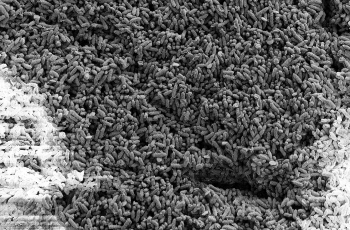The Spacecraft Engineering Department at the Naval Research Laboratory (NRL) has developed an autonomous microbial fuel cell- powered microrover for exploring planetary bodies and remote regions.
 Electron microscope image of the microbe, Geobacter sulfurreducens, the core of the microbial fuel cell-based system.
Electron microscope image of the microbe, Geobacter sulfurreducens, the core of the microbial fuel cell-based system.
The energy necessary for performing repetitive tasks has limited the exploratory expeditions of remote regions and planetary bodies. NRL researchers are investigating autonomous planetary explorers that are less power intensive. The scientists integrated low power electronics, microbial fuel cells and microrobotics technologies to develop a novel microrover weighing around a kilogram.
When compared with lithium-ion power source, MFCs have a higher energy density and longer durability due to reproducibility of microorganisms. But MFCs are associated with large pump systems with high power consumption, MFC volume and mass.
In the study, the control systems and the electronics will be powered by some of the energy that is generated by the MFC. The rest of the energy will be diverted to a capacitor or battery for collection of adequate amount of electricity. When the required power gets stored, the system can use the energy for moving the microrover using a hopping or a tumbling locomotion system. The energy can also be used to power scientific instruments that require high power.
The researchers used Geobacter sulfurreducens, a pure culture anaerobic bacterium for their microbial fuel cell-based system. This technology for generating power has a long lifetime and is capable of recharging capacitors and batteries on board the microrovers, when they undertake exploratory missions for a long period.
Dr. Gregory P. Scott, a space robotics scientist at NRL, stated that the research laid the groundwork for robotic and space applications requiring low powered electronics. He has been awarded a grant to study the novel concept through the NASA Innovative Advanced Concepts (NIAC) program.